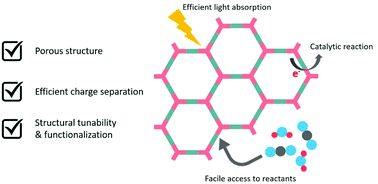Porous framework-based hybrid materials for solar-to-chemical energy conversion: from powder photocatalysts to photoelectrodes
Abstract
Solar-to-chemical energy conversion—so-called “artificial photosynthesis”—is one of the ultimate goals of researchers to realize a sustainable future without the use of fossil fuels. Over a couple of decades, there have been intensive efforts to develop efficient artificial photosynthetic devices. Conventional studies have focused on the design and preparation of such devices using inorganic materials. However, these inorganic materials have many inherent problems, resulting in a low efficiency of solar-to-chemical energy conversion devices. These include a low absorption coefficient, severe surface recombination of charge carriers, low electrical conductivity, and poor catalytic activity. In this regard, porous framework materials such as metal organic frameworks (MOFs) and covalent organic frameworks (COFs) can be considered promising materials for solar-to-chemical energy conversion. Their porous, layered, and ordered structure can impart the following characteristics: (i) high absorption coefficients, (ii) efficient charge separation, (iii) long charge carrier lifetime, and (iv) facile access to reactants. Furthermore, their physicochemical properties can be tailored by varying the linker's chain length, introducing additional functional groups, and employing different symmetry combinations even with similar building blocks. As a result, there have recently been intensive studies on the application of MOFs and COFs for solar-to-chemical energy conversion. In this paper, we review recent efforts on their various solar-to-chemical energy conversion applications. In particular, we have organized recent studies on the basis of their function and target reactions in chronological order to help readers readily understand the progress in MOFs and COFs and challenges to their application in artificial photosynthesis. Last, we suggest the future research direction of growing MOF- and COF-based thin films for more efficient utilization of them.

- This article is part of the themed collection: 2021 Inorganic Chemistry Frontiers Review-type Articles


 Please wait while we load your content...
Please wait while we load your content...